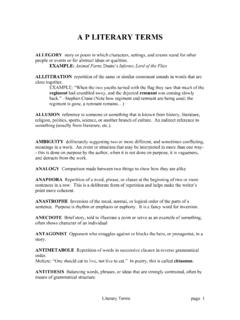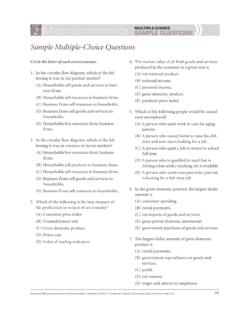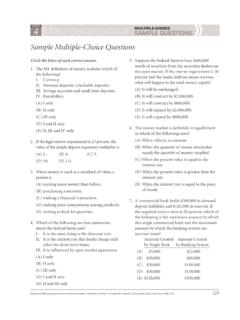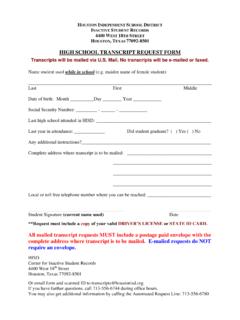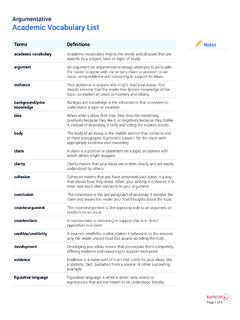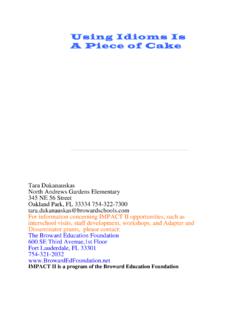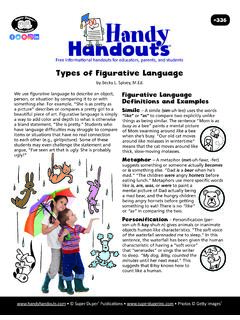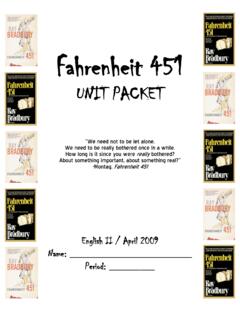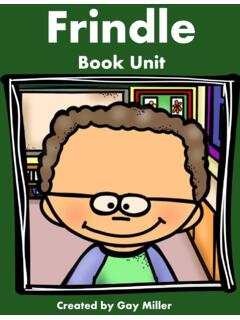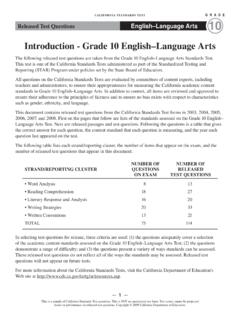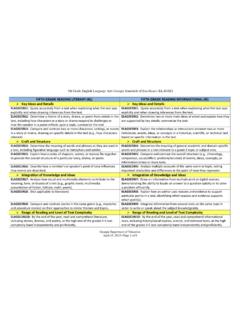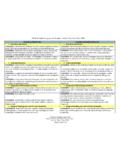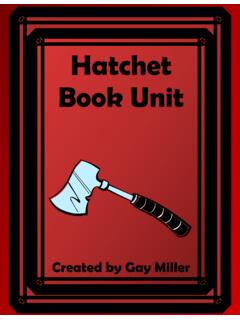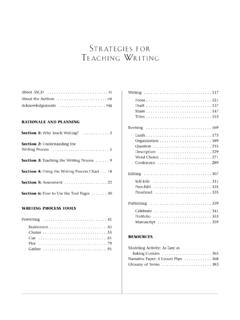Transcription of A P LITERARY TERMS
1 LITERARY TERMS page 1 A P LITERARY TERMS ALLEGORY story or poem in which characters, settings, and events stand for other people or events or for abstract ideas or qualities. EXAMPLE: Animal Farm; Dante s Inferno; Lord of the Flies ALLITERATION repetition of the same or similar consonant sounds in words that are close together. EXAMPLE: When the two youths turned with the flag they saw that much of the regiment had crumbled away, and the dejected remnant was coming slowly back. Stephen Crane (Note how regiment and remnant are being used; the regiment is gone, a remnant ) ALLUSION reference to someone or something that is known from history, literature, religion, politics, sports, science, or another branch of culture. An indirect reference to something (usually from literature, etc.). AMBIGUITY deliberately suggesting two or more different, and sometimes conflicting, meanings in a work.
2 An event or situation that may be interpreted in more than one way-- this is done on purpose by the author, when it is not done on purpose, it is vagueness, and detracts from the work. ANALOGY Comparison made between two things to show how they are alike ANAPHORA Repetition of a word, phrase, or clause at the beginning of two or more sentences in a row. This is a deliberate form of repetition and helps make the writer s point more coherent. ANASTROPHE Inversion of the usual, normal, or logical order of the parts of a sentence. Purpose is rhythm or emphasis or euphony. It is a fancy word for inversion. ANECDOTE Brief story, told to illustrate a point or serve as an example of something, often shows character of an individual ANTAGONIST Opponent who struggles against or blocks the hero, or protagonist, in a story. ANTIMETABOLE Repetition of words in successive clauses in reverse grammatical order.
3 Moliere: One should eat to live, not live to eat. In poetry, this is called chiasmus. ANTITHESIS Balancing words, phrases, or ideas that are strongly contrasted, often by means of grammatical structure. LITERARY TERMS page 2 ANTIHERO Central character who lacks all the qualities traditionally associated with heroes. may lack courage, grace, intelligence, or moral scruples. ANTHROPOMORPHISM attributing human characteristics to an animal or inanimate object (Personification) APHORISM brief, cleverly worded statement that makes a wise observation about life, or of a principle or accepted general truth. Also called maxim, epigram. APOSTROPHE calling out to an imaginary, dead, or absent person, or to a place or thing, or a personified abstract idea. If the character is asking a god or goddess for inspiration it is called an invocation. Josiah Holland --- Loac on!
4 Thou great embodiment/ Of human life and human history! APPOSITION Placing in immediately succeeding order of two or more coordinate elements, the latter of which is an explanation, qualification, or modification of the first (often set off by a colon). Paine: These are the times that try men s souls: The summer soldier and the sunshine patriot will in this crisis, shrink from the service of his country; but he that stands it Now, deserves the love and thanks of man and woman. ASSONANCE the repetition of similar vowel sounds followed by different consonant sounds especially in words that are together. ASYNDETON Commas used without conjunction to separate a series of words, thus emphasizing the parts equally: instead of X, Y, and the writer uses X,Y, see polysyndeton. BALANCE Constructing a sentence so that both halves are about the same length and importance. Sentences can be unbalanced to serve a special effect as well.
5 CHARACTERIZATION the process by which the writer reveals the personality of a character. INDIRECT CHARACTERIZATION the author reveals to the reader what the character is like by describing how the character looks and dresses, by letting the reader hear what the character says, by revealing the character s private thoughts and feelings, by revealing the characters effect on other people (showing how other characters feel or behave toward the character), or by showing the character in action. Common in modern literature DIRECT CHARACTERIZATION the author tells us directly what the character is like: sneaky, generous, mean to pets and so on. Romantic style literature relied more heavily on this form. STATIC CHARACTER is one who does not change much in the course of a story. LITERARY TERMS page 3 DYNAMIC CHARACTER is one who changes in some important way as a result of the story s action.
6 FLAT CHARACTER has only one or two personality traits. They are one dimensional, like a piece of cardboard. They can be summed up in one phrase. ROUND CHARACTER has more dimensions to their personalities---they are complex, just a real people are. CHIASMUS In poetry, a type of rhetorical balance in which the second part is syntactically balanced against the first, but with the parts reversed. Coleridge: Flowers are lovely, love is flowerlike. In prose this is called antimetabole. CLICHE is a word or phrase, often a figure of speech, that has become lifeless because of overuse. Avoid clich s like the plague. (That clich is intended.) COLLOQUIALISM a word or phrase in everyday use in conversation and informal writing but is inappropriate for formal situations. Example: He s out of his head if he thinks I m gonna go for such a stupid idea. COMEDY in general, a story that ends with a happy resolution of the conflicts faced by the main character or characters.
7 CONCEIT an elaborate metaphor that compares two things that are startlingly different. Often an extended metaphor. CONFESSIONAL POETRY a twentieth century term used to describe poetry that uses intimate material from the poet s life. CONFLICT the struggle between opposing forces or characters in a story. EXTERNAL CONFLICT conflicts can exist between two people, between a person and nature or a machine or between a person a whole society. INTERNAL CONFLICT a conflict can be internal, involving opposing forces within a person s mind. CONNOTATION the associations and emotional overtones that have become attached to a word or phrase, in addition to its strict dictionary definition. COUPLET two consecutive rhyming lines of poetry. DIALECT a way of speaking that is characteristic of a certain social group or of the inhabitants of a certain geographical area. LITERARY TERMS page 4 DICTION a speaker or writer s choice of words.
8 DIDACTIC form of fiction or nonfiction that teaches a specific lesson or moral or provides a model of correct behavior or thinking. ELEGY a poem of mourning, usually about someone who has died. A Eulogy is great praise or commendation, a laudatory speech, often about someone who has died. EPANALEPSIS device of repetition in which the same expression (single word or phrase) is repeated both at the beginning and at the end of the line, clause, or sentence. Voltaire: Common sense is not so common. EPIC a long narrative poem, written in heightened language , which recounts the deeds of a heroic character who embodies the values of a particular society. EPIGRAPH a quotation or aphorism at the beginning of a LITERARY work suggestive of the theme. EPISTROPHE Device of repetition in which the same expression (single word or phrase) is repeated at the end of two or more lines, clauses, or sentences (it is the opposite of anaphora).
9 EPITHET an adjective or adjective phrase applied to a person or thing that is frequently used to emphasize a characteristic quality. Father of our country and the great Emancipator are examples. A Homeric epithet is a compound adjective used with a person or thing: swift-footed Achilles ; rosy-fingered dawn. ESSAY a short piece of nonfiction prose in which the writer discusses some aspect of a subject. ESSAY TYPES TO KNOW: ARGUMENTATION one of the four forms of discourse which uses logic, ethics, and emotional appeals (logos, ethos, pathos) to develop an effective means to convince the reader to think or act in a certain way. PERSUASION relies more on emotional appeals than on facts ARGUMENT form of persuasion that appeals to reason instead of emotion to convince an audience to think or act in a certain way. CAUSAL RELATIONSHIP Form of argumentation in which the writer claims that one thing results from another, often used as part of a logical argument.
10 LITERARY TERMS page 5 DESCRIPTION a form of discourse that uses language to create a mood or emotion. EXPOSITION one of the four major forms of discourse, in which something is explained or set forth. NARRATIVE the form of discourse that tells about a series of events. EXPLICATION act of interpreting or discovering the meaning of a text, usually involves close reading and special attention to figurative language . FABLE a very short story told in prose or poetry that teaches a practical lesson about how to succeed in life. FARCE a type of comedy in which ridiculous and often stereotyped characters are involved in silly, far-fetched situations. figurative language Words which are inaccurate if interpreted literally, but are used to describe. Similes and metaphors are common forms. FLASHBACK a scene that interrupts the normal chronological sequence of events in a story to depict something that happened at an earlier time.
